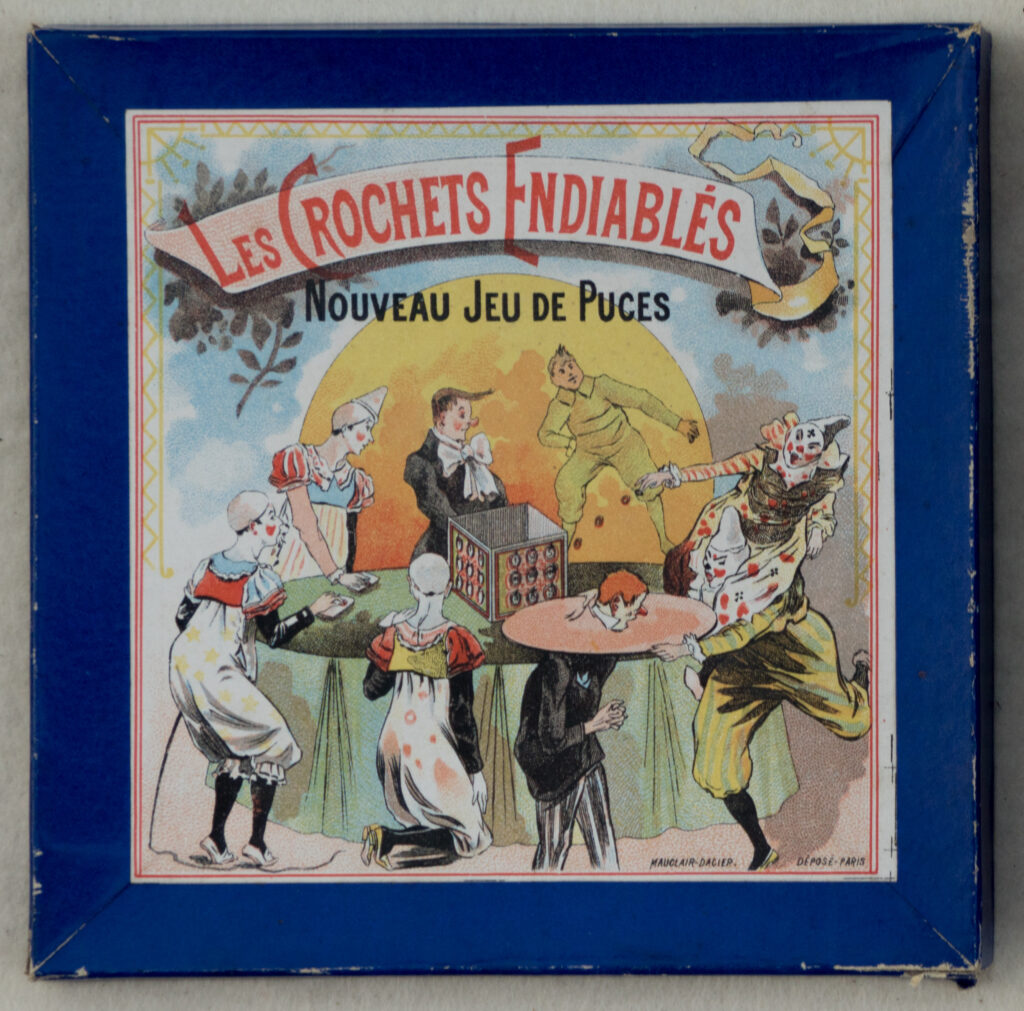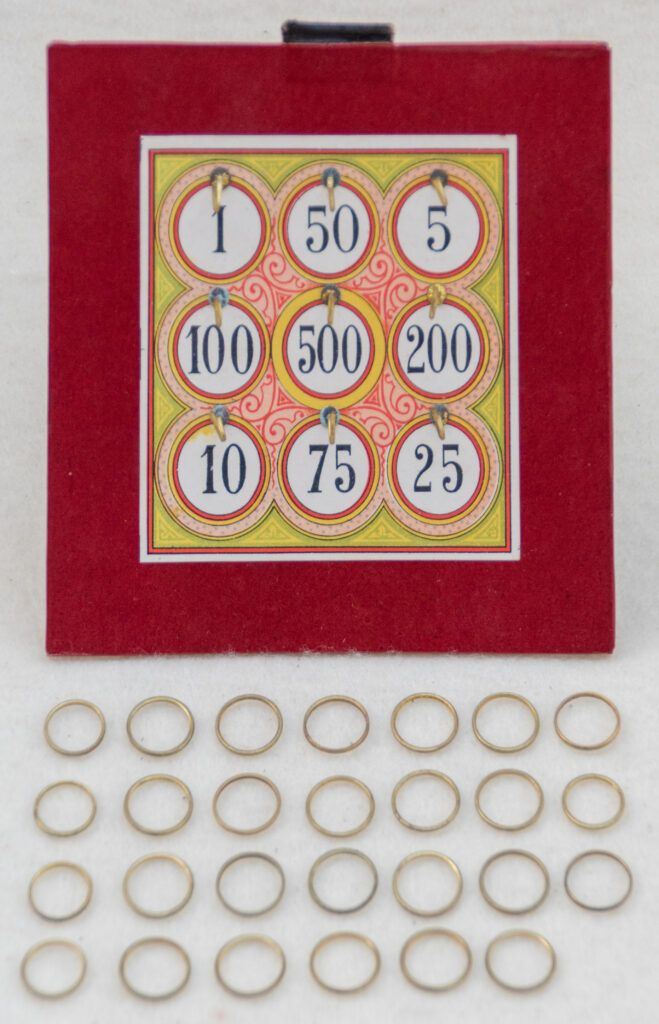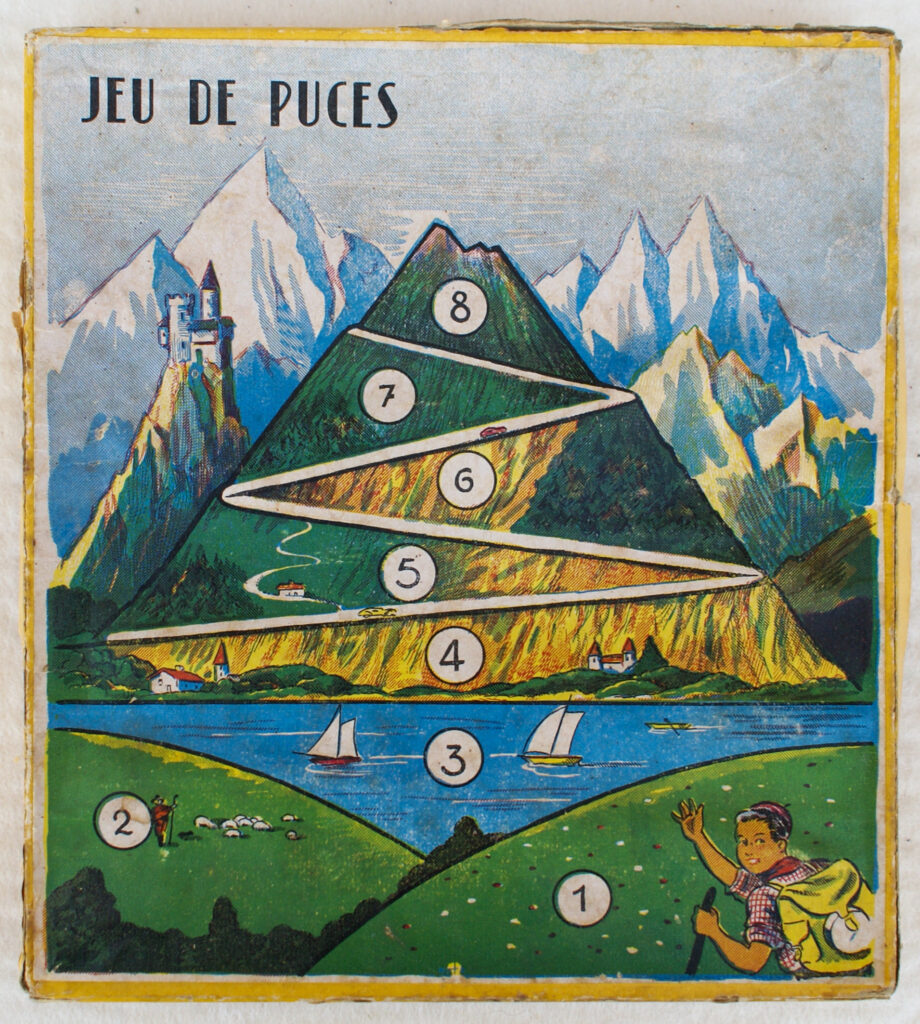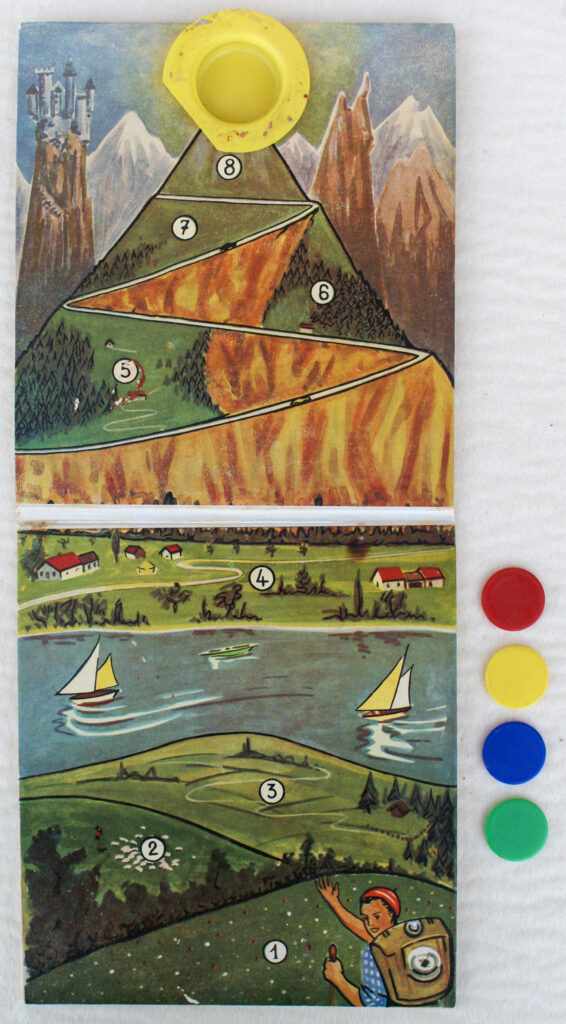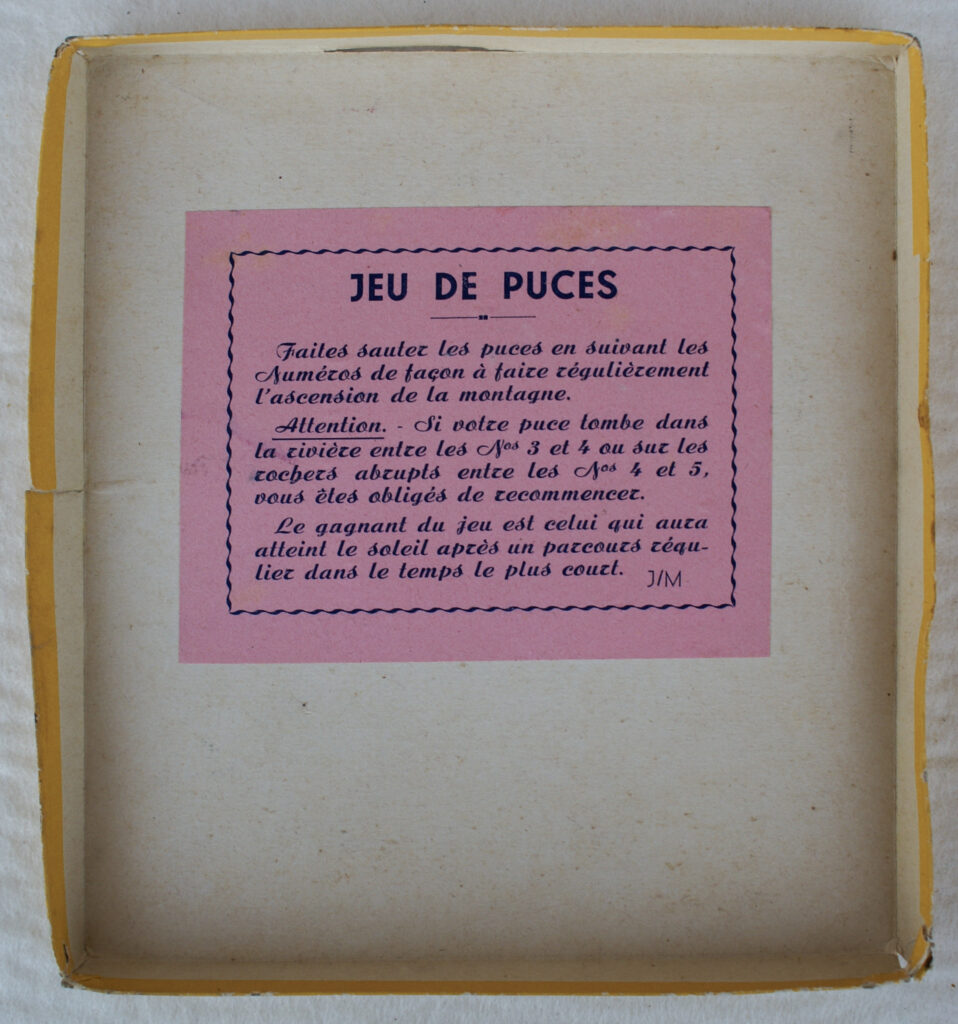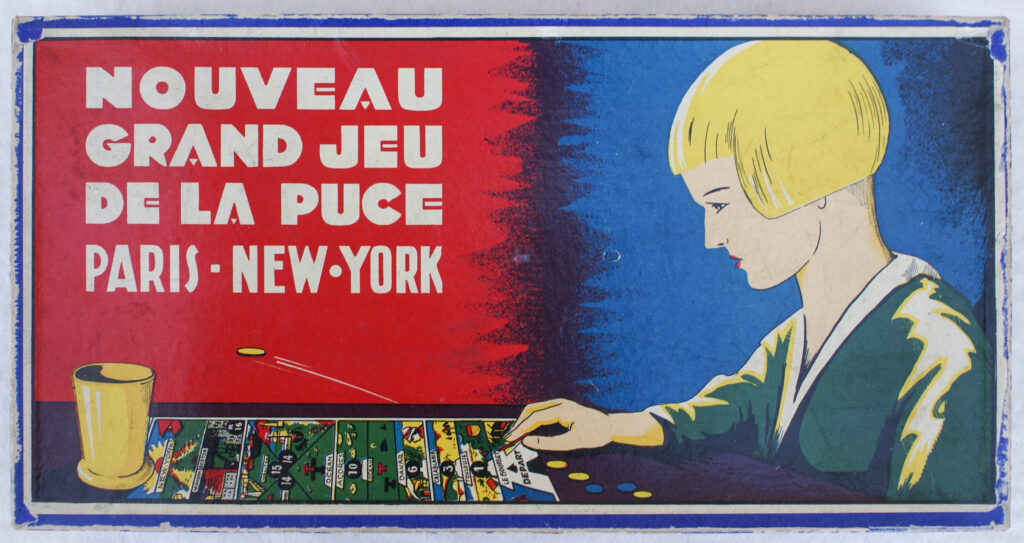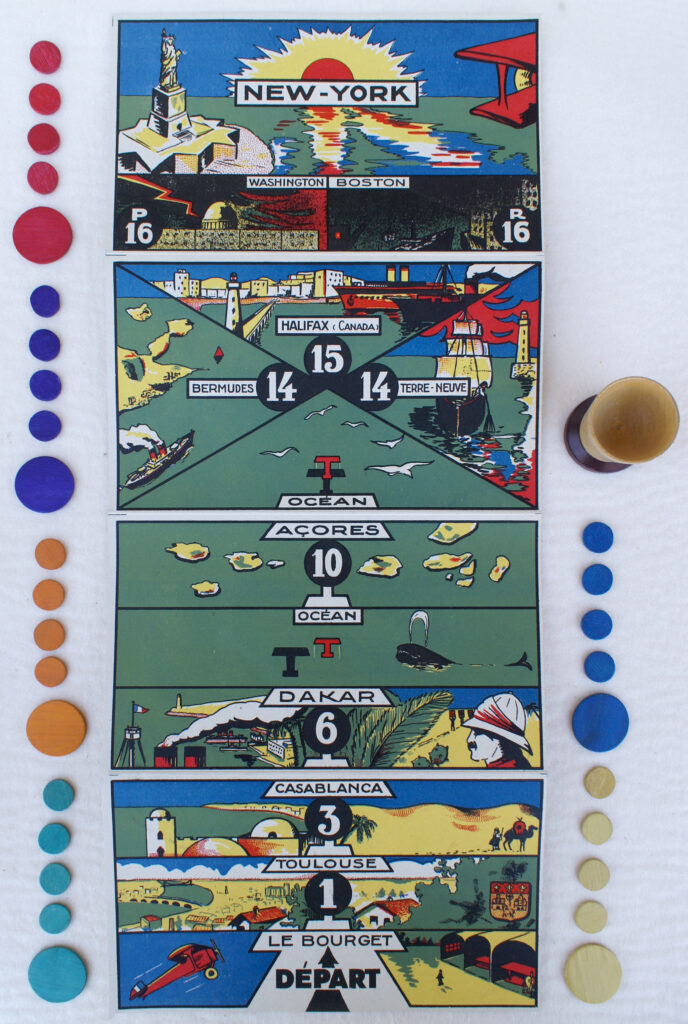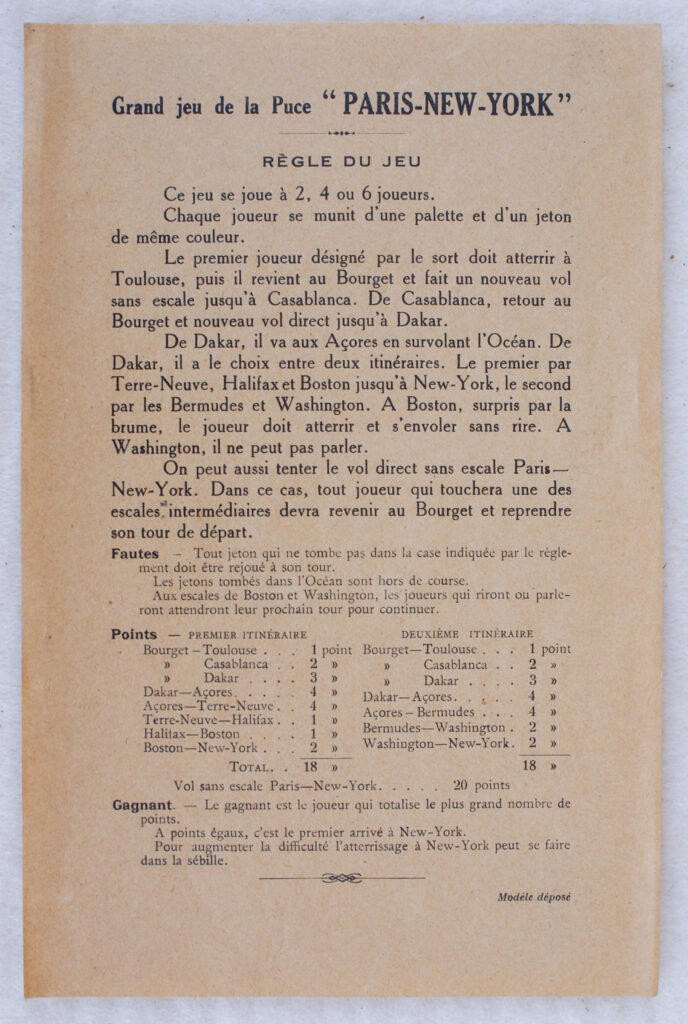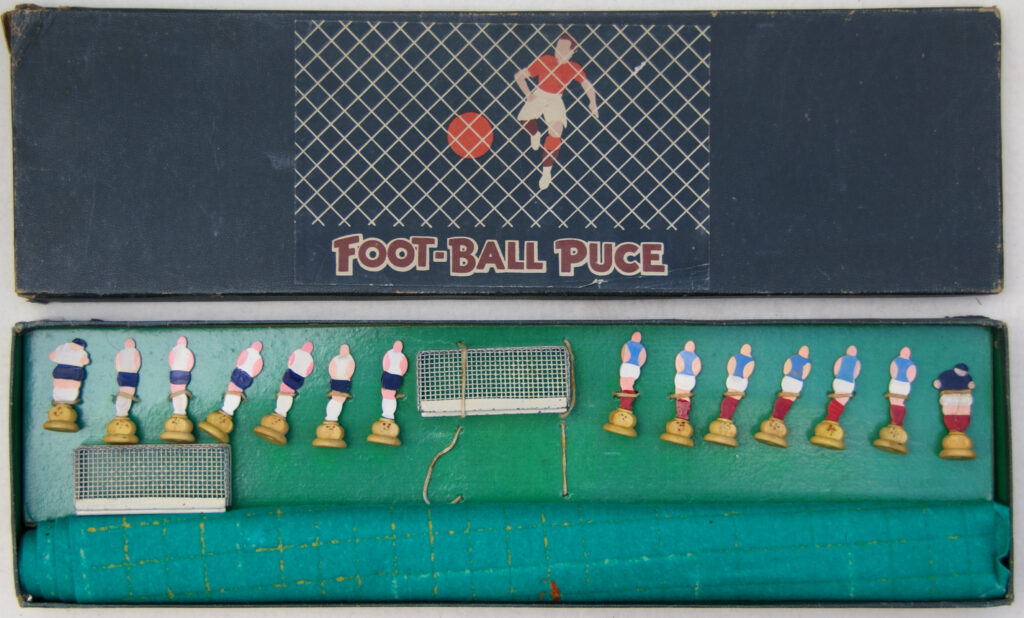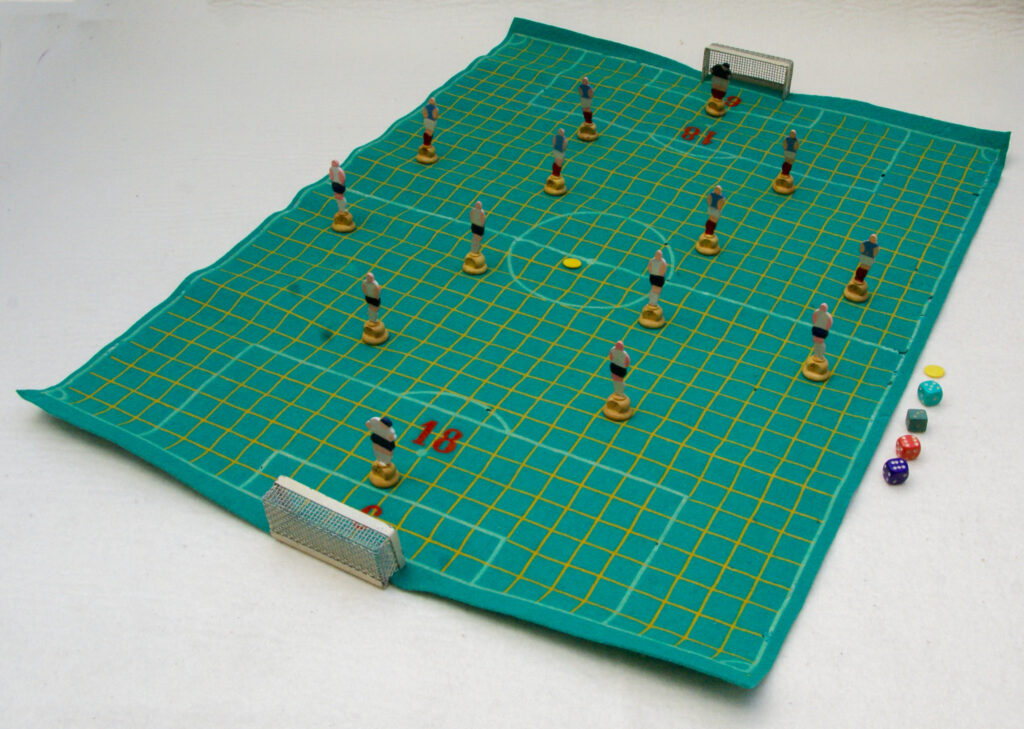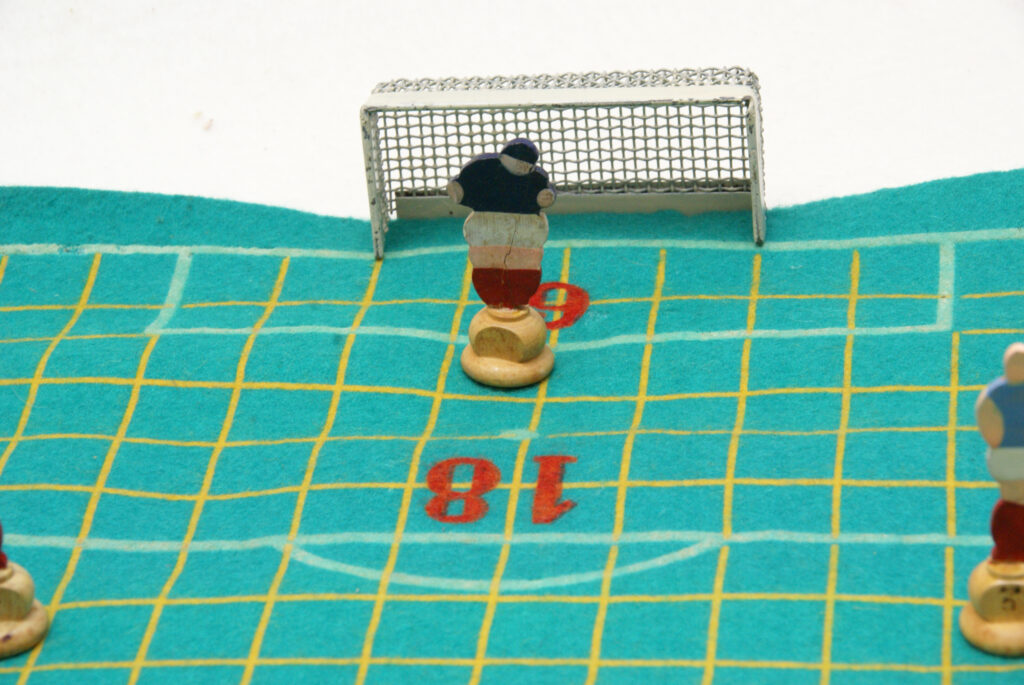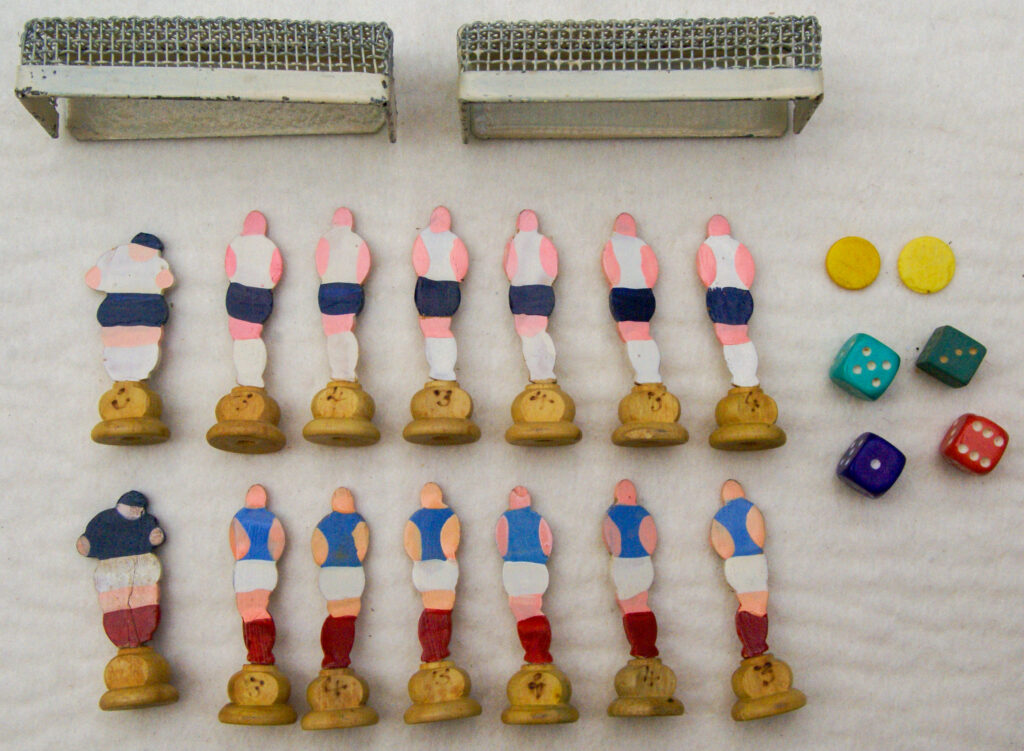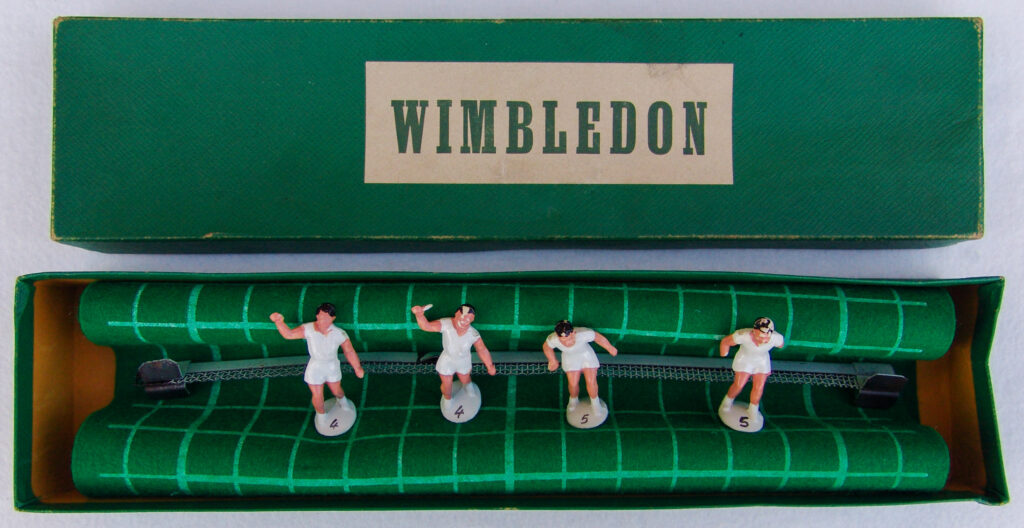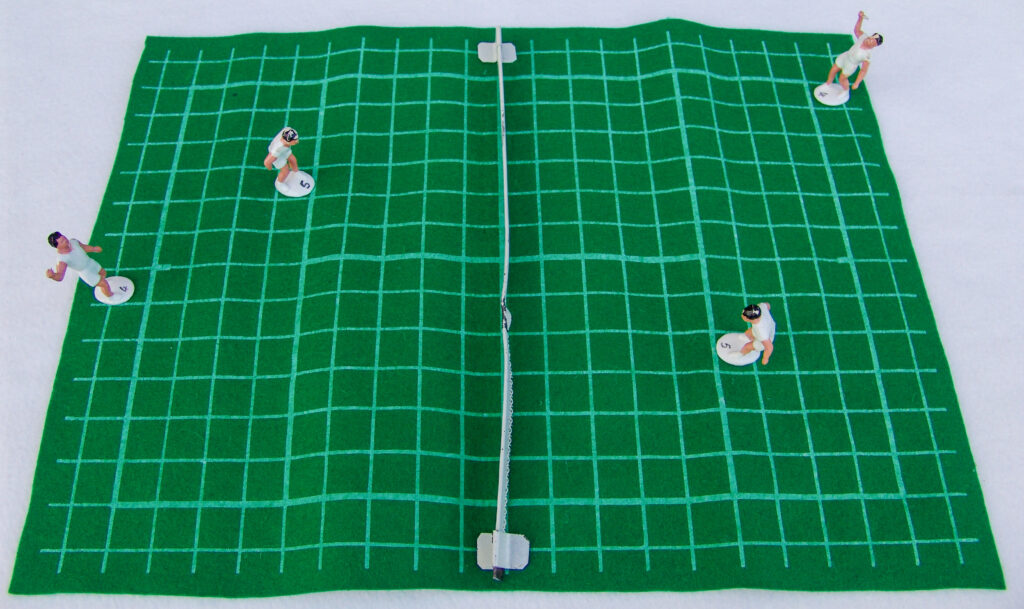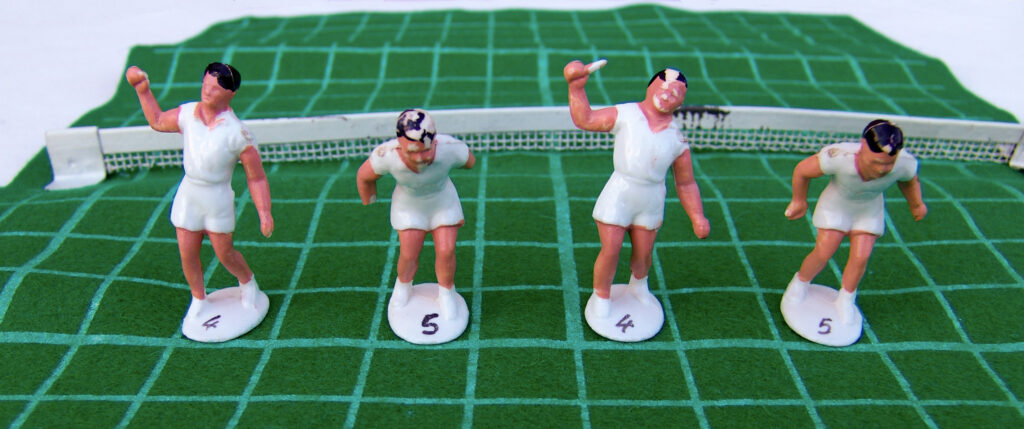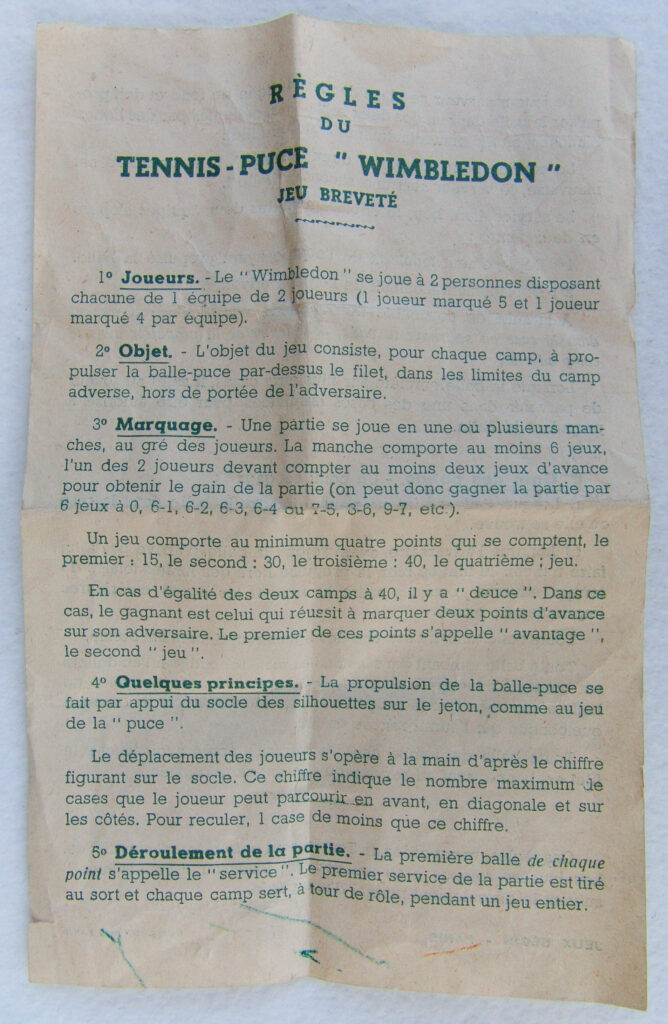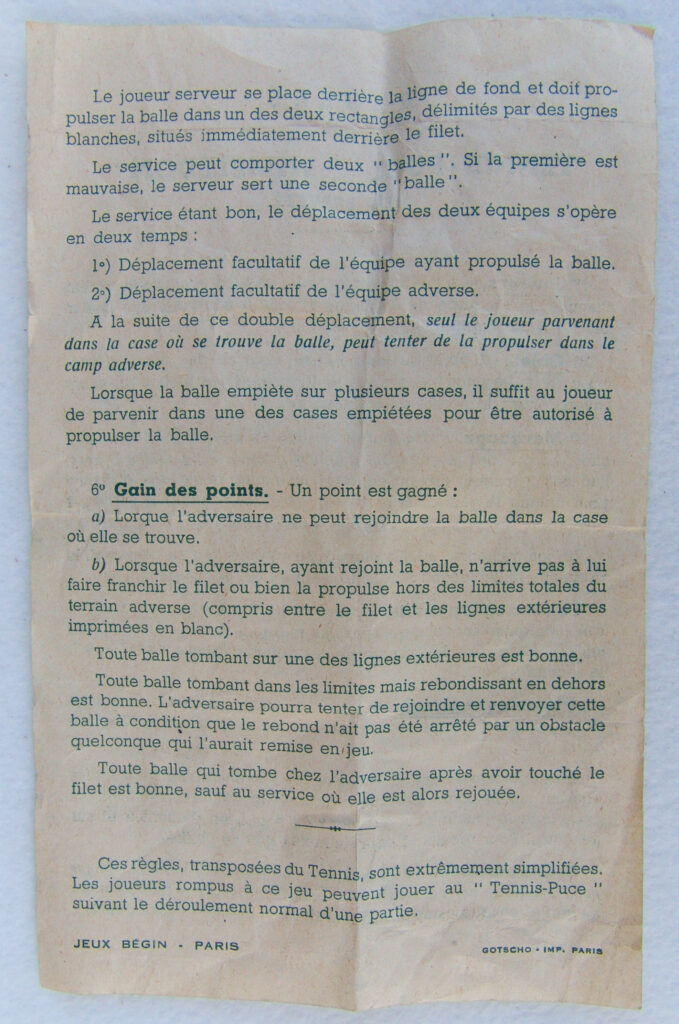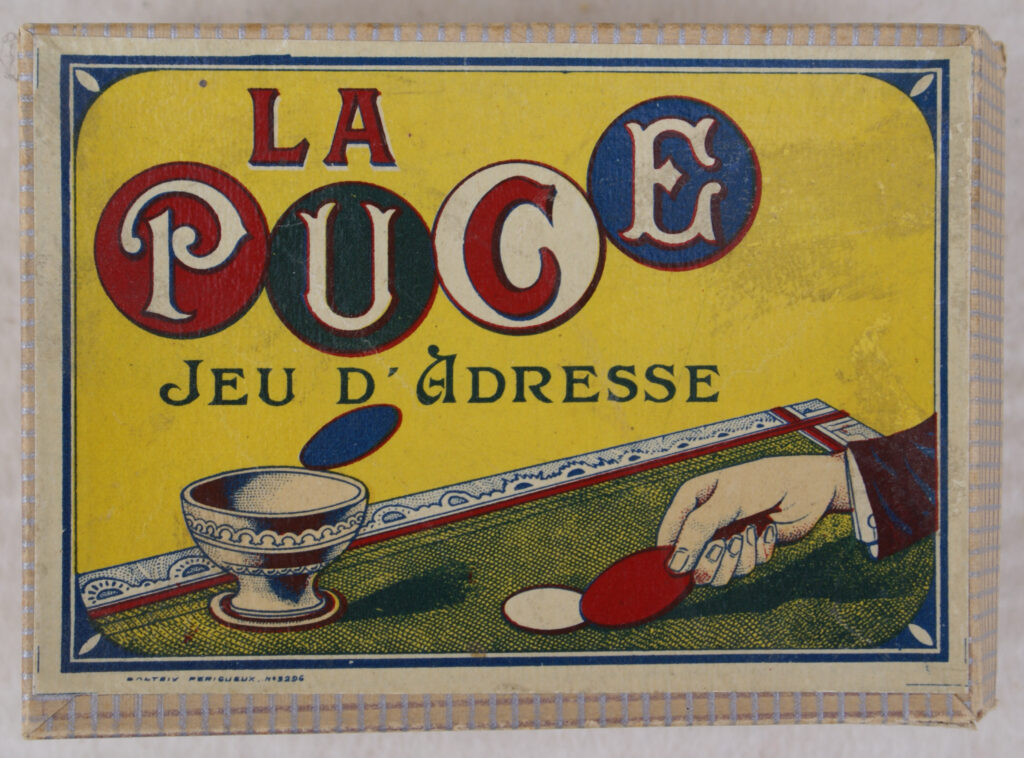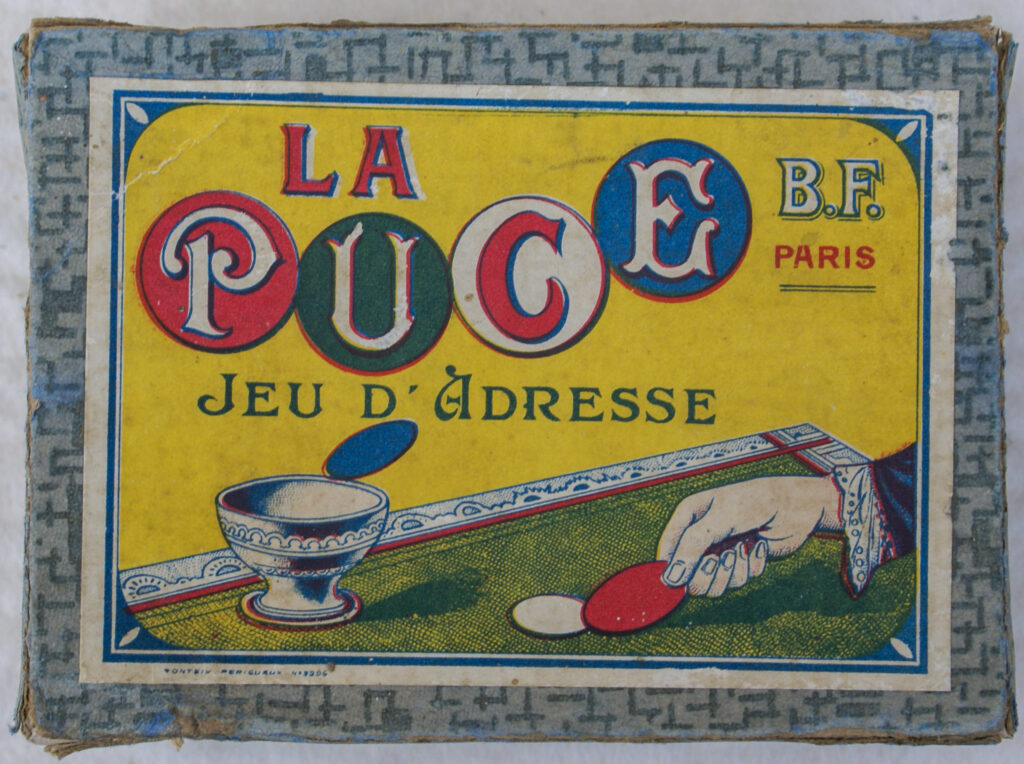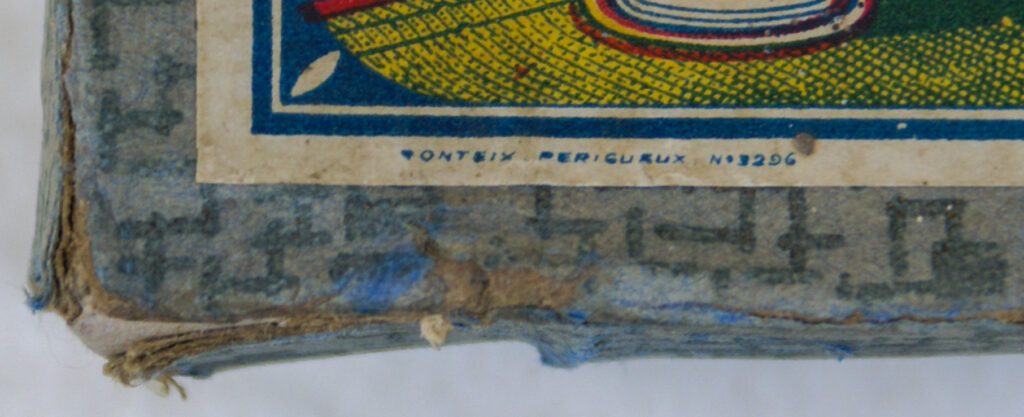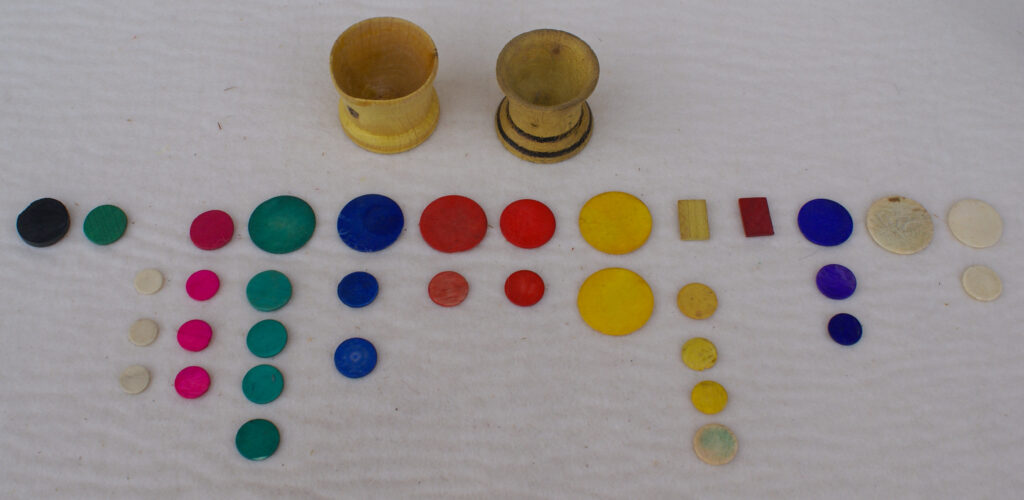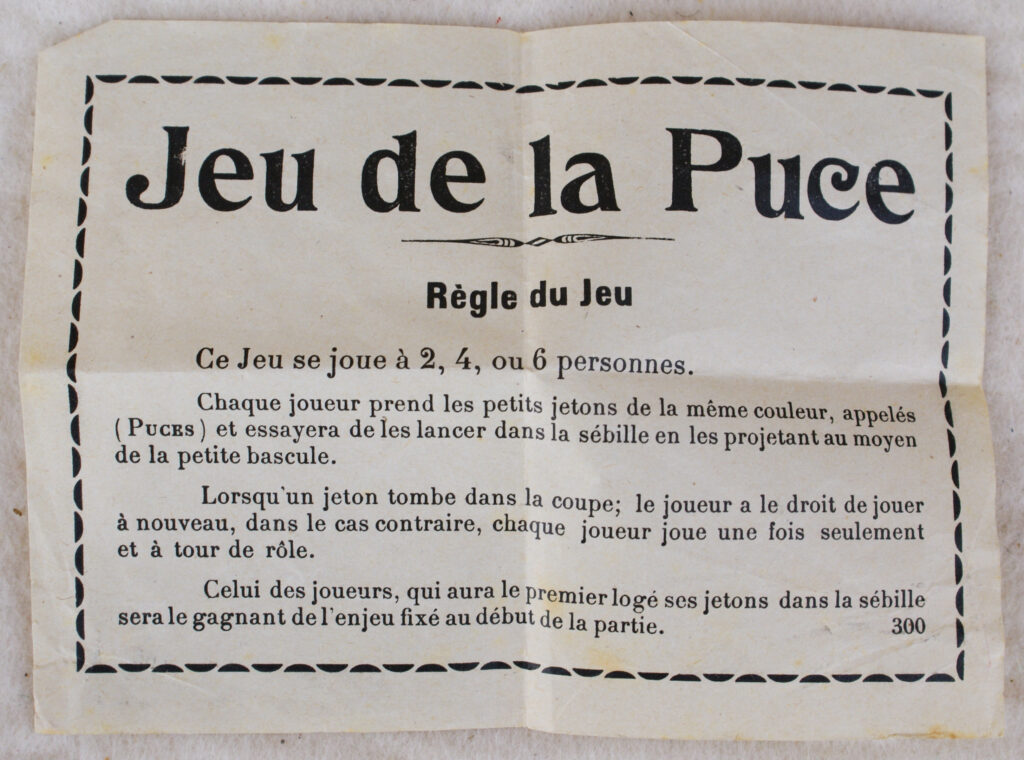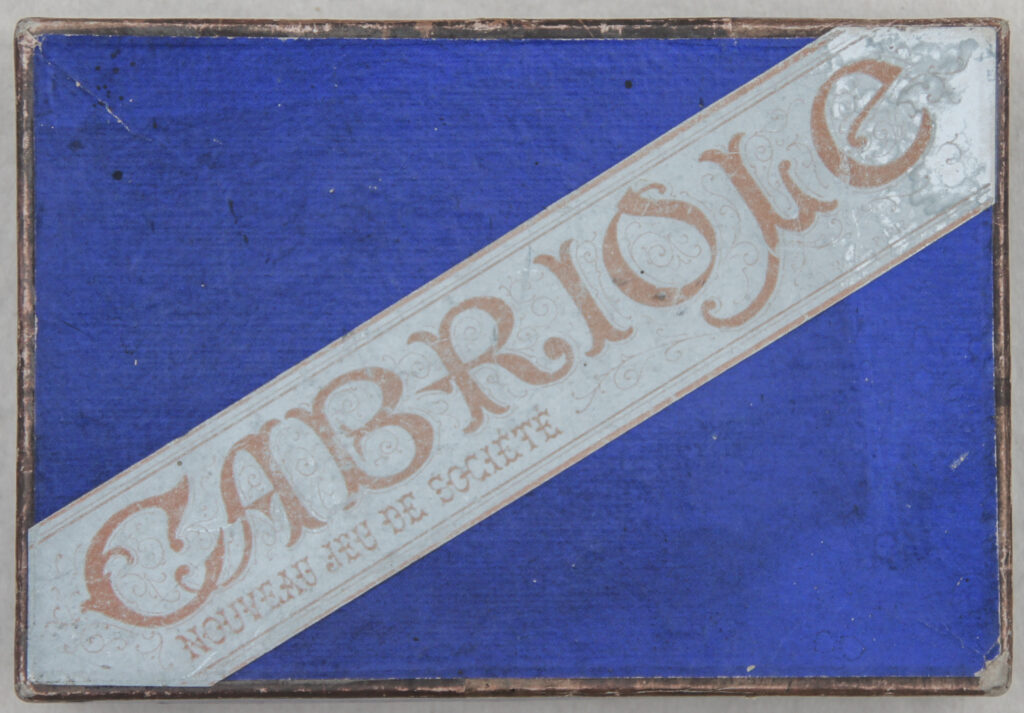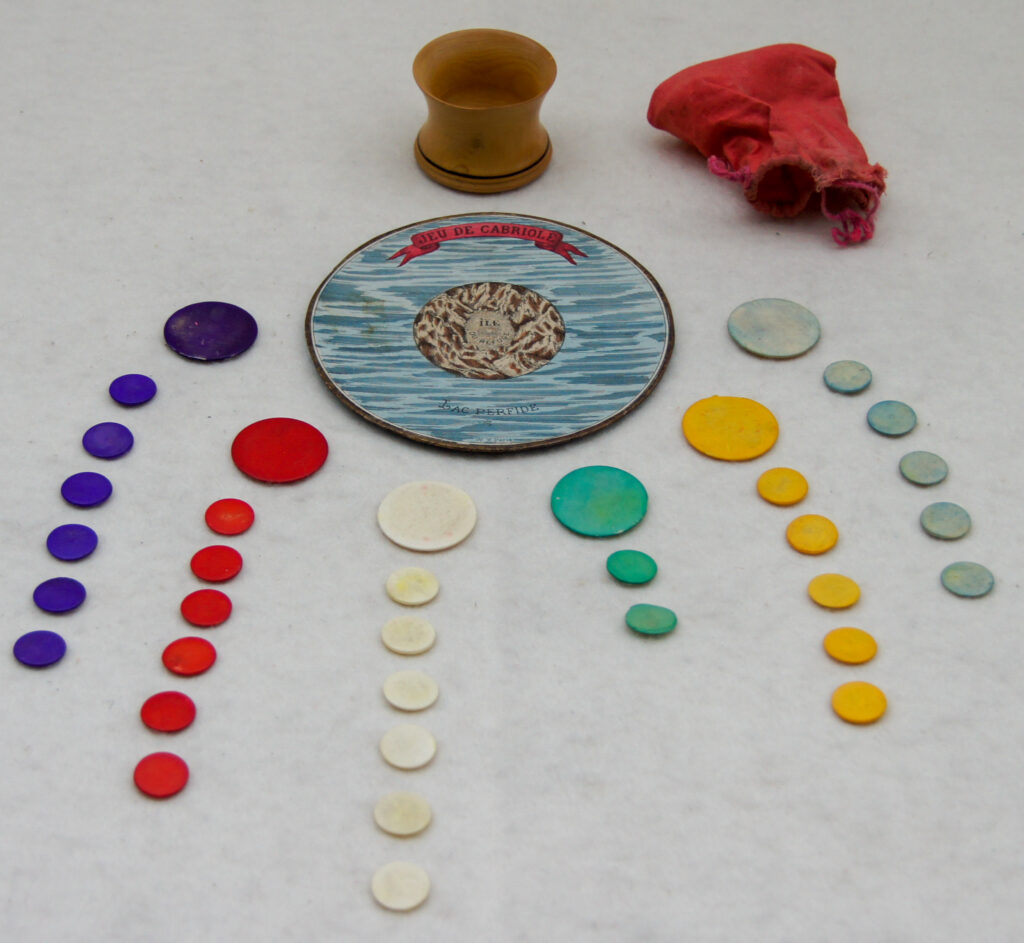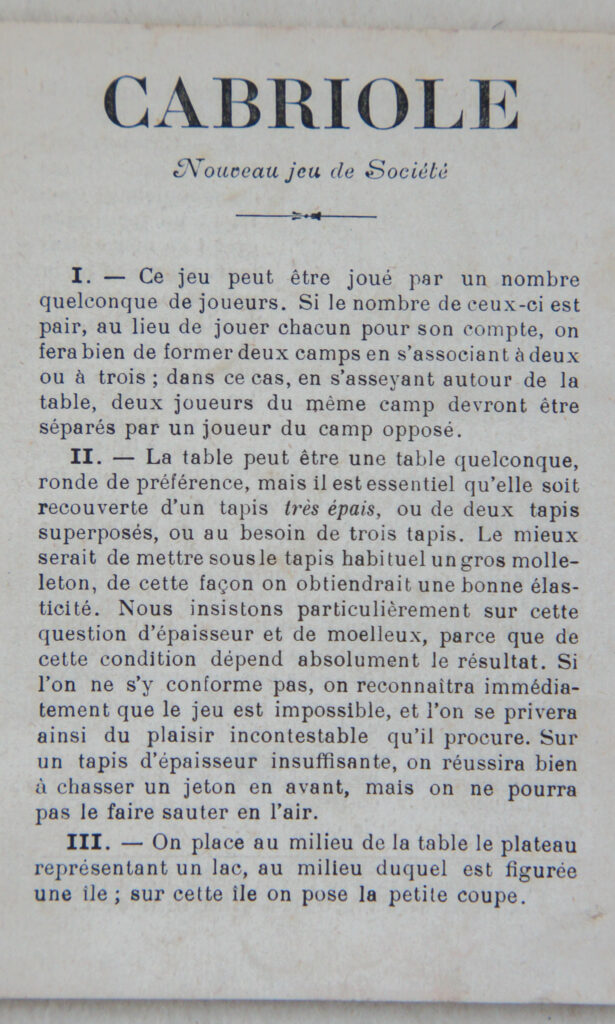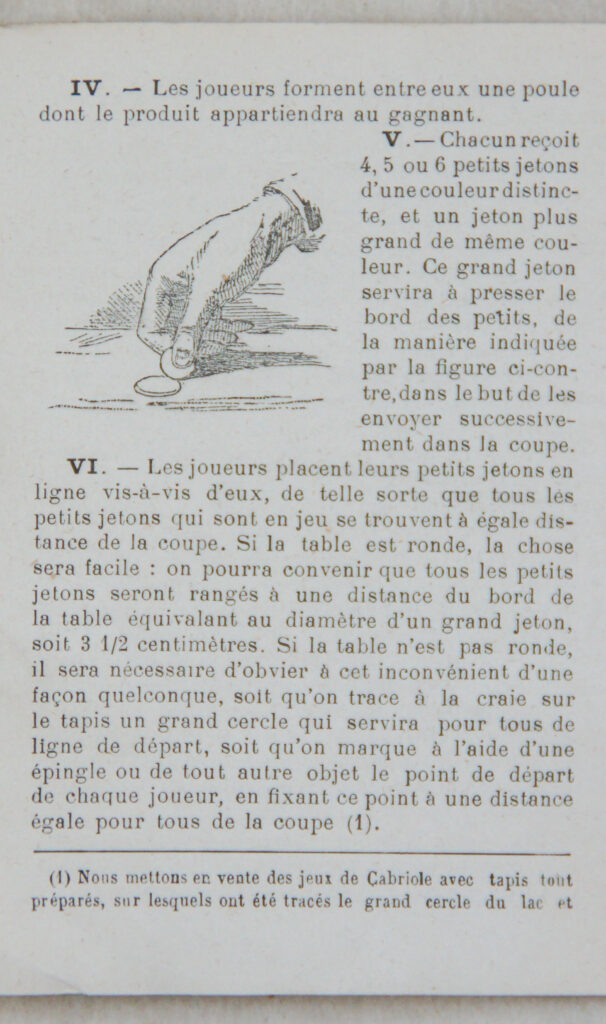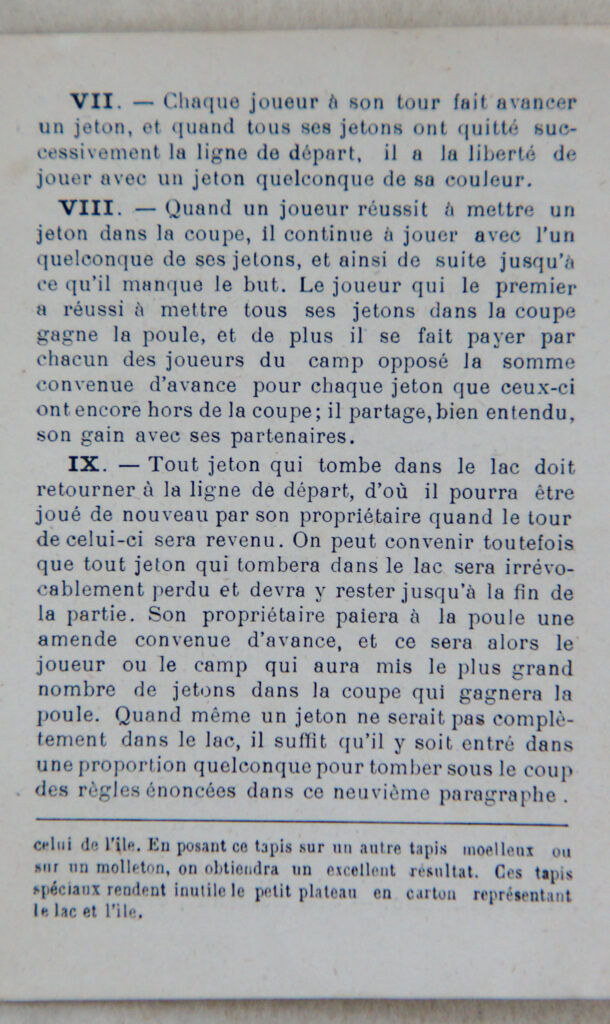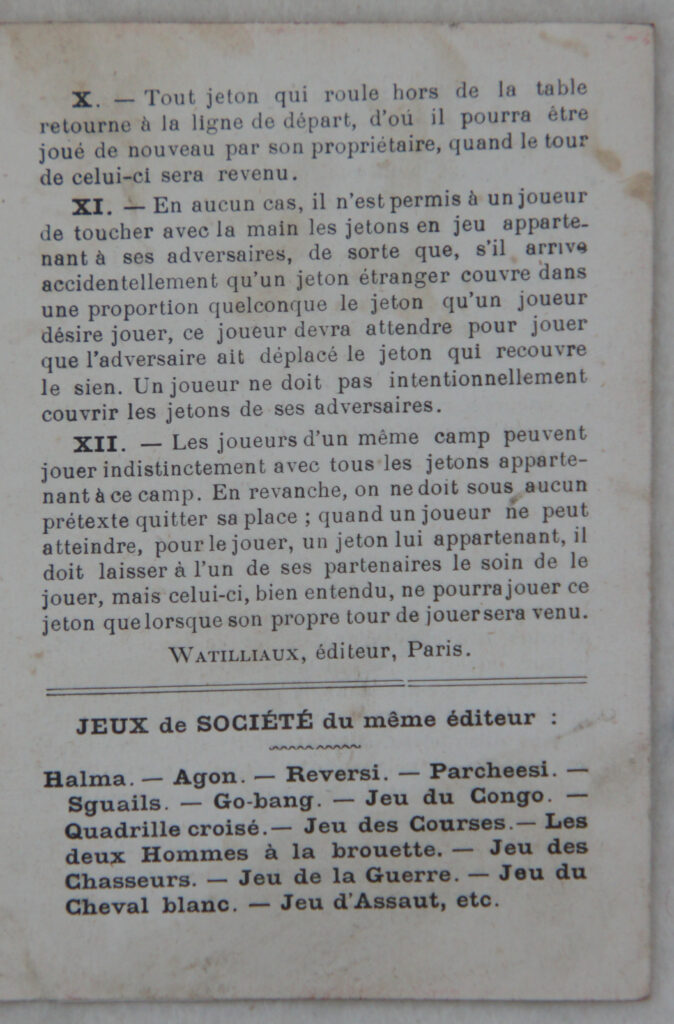Nicolas & Keller (N. K. Atlas)
In 1904, Léon Nicolas & Charles Keller formed their company, known as N. K. Atlas, on rue de l’Atlas in Paris. The company produced numerous games through 1924, when it was acquired by Georges Bonnet, who continued to produce a variety of games under the GB mark, including several varieties of French tiddlywinks (jeu de la puce). This particular game was called LA PUCE.
Yet another fun French tiddlywinks game by N. K. Atlas debuted in the same early years. Of course, it was still called LA PUCE Nouveau Jeu (The Flea • New Game) with the logo of “N. K.Atlas” in the lower-right corner.
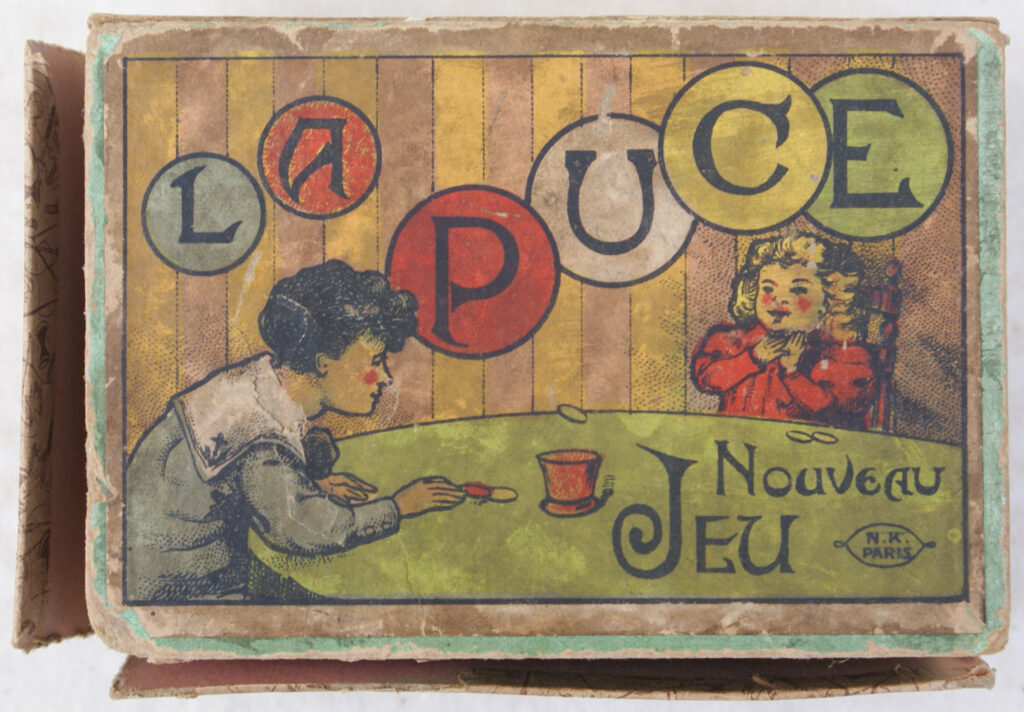
N. K. Atlas also produced LA PUCE DOMPTÉE • COMBINAISON NOUVELLE DU JEU DE LA PUCE (The Tamed Flea • New Combination of the Game of the Flea) in which the winks are rings to be shot toward a numbered target with 9 hooks to catch the winks.
GRAND JEU DE LA PUCE by N. K. Atlas includes a hopscotch-styled target that may seem quite odd given that it portrays a progression of game play from the start at the bottom, through numbered checkpoints, and then through (but avoiding) Hell to a Resting Spot (Reposoir) and ultimately to Paradise at the top of the game target. Curiously enough, almost identical tiddlywinks game targets are found in many other French tiddlywinks games from this era, but not in tiddlywinks games from any other countries. The progression of shooting winks from stage to stage on the tiddlywinks game target is described in the rules; here’s a translation of them:
N. K. PARIS
GRAND JEU DE LA PUCE RÈGLE DU JEU I. — The three rectangles marked 1, 2, 3, are called Manches (Stages) and the two quarter circles drawn at the extreme corners of the first level are called Cabarets; then there is l'Enfer (Hell) and Reposoir (Resting Place), then four triangles numbered from 1 to 4 that we will call Equerres; and following the squares there are two rectangles P and R. These two letters mean Parler (Speak) and Rire (Laugh): Finally the semicircle at the top of the board is called Paradise. II. — The play of our game, which requires some skill and a certain hand-eye coordination, is about the same as that of Marelle's ancient game (Hopscotch). It's a salon game that lends a lot to laughter; we gave it the name of Grand Jeu de la Puce, because propelling the winks in the way that we do reminds us quite like shooting winks in the game La Puce.. III. — Each player makes a bet and takes two special colored discs, one of which will be used to shoot the other forward. There are, in addition, some spare discs. The total bets constitute a pool and will be the winner's prize. IV. — The player selected by chance to play first places one of his winks on the circle at the start, and with his squidger, he presses the edge of the wink so as to flick it into the first stage with 1, 2, and 3. If he does not succeed, he gives way to the second player; but if he succeeds, he takes his wink out of the first area. Then placing his wink again on the starting circle, he sends it towards the second stage. and if successful, returns to the starting circle and then shoots it towards the third stage and makes it out. To get out, the wink can be shot the distance that separates it from the starting circle, either in a single jump or in several jumps. V. — It is now a question of sending the wink to the Resting Place, jumping over Hell, in which one must never stop; from the Resting Place his wink is passed directly into the first square; then successively in the 2nd, 3rd and 4th. It goes without saying that in these two cases the player will have to be well warned against the tricks that his opponents will deploy to put him in default. Finally, from box R, we move his wink in Paradise. VI. — Then it is only necessary to retrace his steps by passing successively through all the parts of the table and stopping in each of them, except in Hell. VII. — The player who fortunately completes all these operations has won the game; depending on the number of players there will also be a second and even a third place. VIII. — Everything that has been said above must be done without the winks stopping on the lines and without them going off the board, by the right and left sides of the board or through the Cabarets.
Mauclair–Dacier • Paris, France
Mauclair-Dacier was a publisher of French games from the 1880s through 1904 when the company was acquired by Les Jeux Réunis. Their games typically were marked only with “M. D. Paris”. They produced quite a few tiddlywinks and other games during their short existence.
Here’s an early game by Mauclair-Dacier. LA PUCE • NOUVEAU JEU (The Flea• New Game) simply portrays a hand entering into the cover illustration at lower right, holding a red squidger against a green wink, with a red wink in the the air about to enter the pot on the left of the cover. Plus, the individual letters of “LA PUCE” each are shown inside a series of colored winks forming “LA PUCE” from left to right.
And here’s another quality tiddlywinks game by Mauclair-Dacier of Paris: LES CROCHETS ENDIABLÉS • NOUVEAU JEU DE PUCES (The Crazy Hooks • New Game of Fleas). The cover depicts seven people wearing an odd assortment of garb. The clown is shown exuding winks towards the game target. An interesting and intriguing illustration, indeed!
The game target stands vertically with the help of a support behind. The target consists of 9 hooks onto which players aim to shoot their metal rings. An incredibly wide range of point values are associated with these 9 hooks, from 1 at upper left to 500 at center.
French • Unknown • Jeu de Puce
The following tiddlywinks game revolves around propelling winks up along the turnabout roads on a tall mountain by a lake with boats with a hiker on the shore nearby. While the maker of this game is not noted on it (other than the cryptic “J/M” appearing on the rules), the title of the game is in French, and is simply JEU DE PUCES.
Yet another game that doesn’t indicate its French maker: NOUVEAU GRAND JEU DE LA PUCE • PARIS • NEW-YORK. This is quite an interesting game given that it employs a target that resembles a hopscotch-style progression that in earlier games aimed to reach Paradise, but in this game the departure point is from the Paris airport, Le Bourget, and then progresses through Toulouse and then Casablanca and Dakar, and oh, then skipping across the Ocean to the Açores (the Azores) and then across the Ocean again. Next upward on the 14 point areas are either Bermuda (Bermudes) or Newfoundland (Terre-Neuve). Then upward to the 15 point area, which is marked Halifax in Canada. Moving upward again, the winks and points head into the U.S. of A. Hence, the next stage, numbered with 16, has Washington on the left and Boston on the right.
At the apex of the target surface’s illustration is the city of New-York with the Statue of Liberty and a sunrise over the river.
Les Jeux Bégin • Paris, France
The game of FOOT-BALL PUCE (international association football, not American football) was produced by Les Jeux Bégin. Each of the two sides has a goalie and 6 field players, each of which is mounted on a round base. The round base is used as a squidger to flick the wink around the felt playing pitch. Metal goals are placed at each end of the felt pitch. The game is reported to have been produced in 1947.
Another edition of this game has a cover with a red background rather than the dark green one shown here. A separate edition of this game comes with dark green background on the cover with a goalie and 11 field players for each side. And yet another version comes with a red background on the cover and just a goalie and 2 field players on each side.
Les Jeux Bégin of Paris also came out with a tennis tiddlywinks game called WIMBLEDON. This game is similar in design to FOOT-BALL PUCE shown above, given that the 4 provided tennis player figurines (wearing white, of course!) have round bases that are used as squidgers to shoot winks across the net on the felt tennis court surface.
The lines marking the major sections of the tennis court in the images below are not particularly discernible; another edition of this game has a yellow grid background (instead of green) with white lines marking the major sections of the court.
B. F. • Paris
The following game has been found in a number of very similar varieties. One version of the game does not identify the maker of the game. But since one of the versions is marked B. F. Paris, we place this series of basic tiddlywinks games under the company B. F. in Paris. The game title is given simply LA PUCE (The Flea) and the cover identifies the game in French as a Jeu d’Adresse (game of skill). As with many basic tiddlywinks games produced in the UK (notably from John W. Spear & Son) and France, it shows a hand shooting a wink toward a pot on the cover, but does not show faces nor any other portions of the human body in its illustrations.
To date, we have not uncovered what “B. F.” stands for.
In the lower left corners of the covers of these games, the text PONTEIX PERIGUEUX No 3296 appears. Périgueux is a city in France.
Alphonse Wogue • A. W. Paris
The Alphonse Wogue company of Paris produced this GRAND JEU DE LA PUCE game, marked as “A. W. Paris”. Images of four children fill the cover, which also depicts the multiple stages of the progression of winks across the reddish target, from the start (Départ) through 1, 2, and 3, and then across Enfer (Hell) and then Reposoir (Resting Space). Several animal hopscotch triangular areas are shown above those target markings, and then, above, there’s “R” at left (representing “Rire” (to Laugh) as described above) and “P” (representing “Parler” (to Speak) as described above) at right, and then, of course, “PARADIS” as nirvana at the top of the target.
[Thanks to Charlie Gross for alerting us that “A. W.” on this game refers to Alphonse Wogue.]
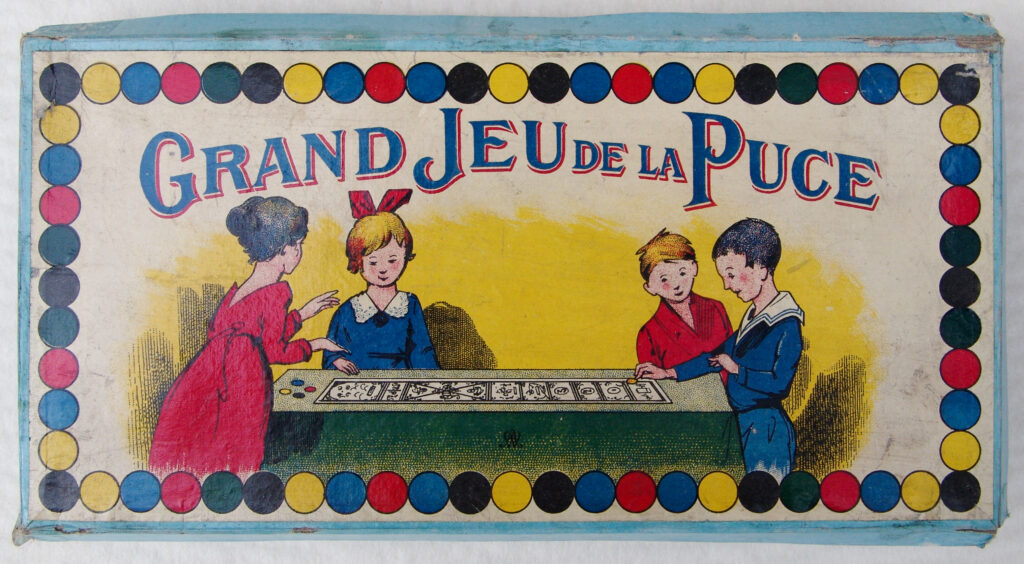
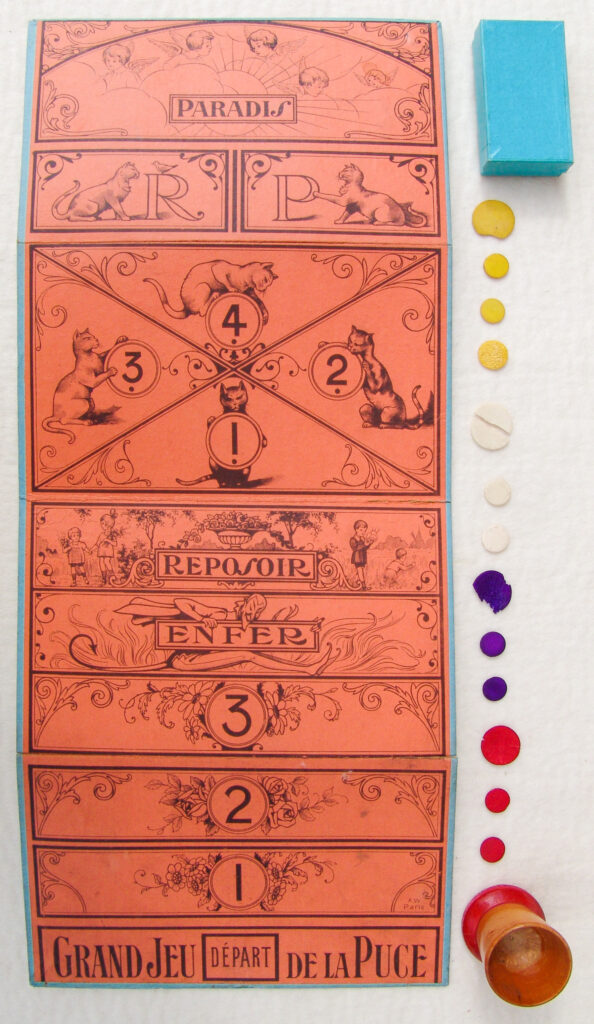
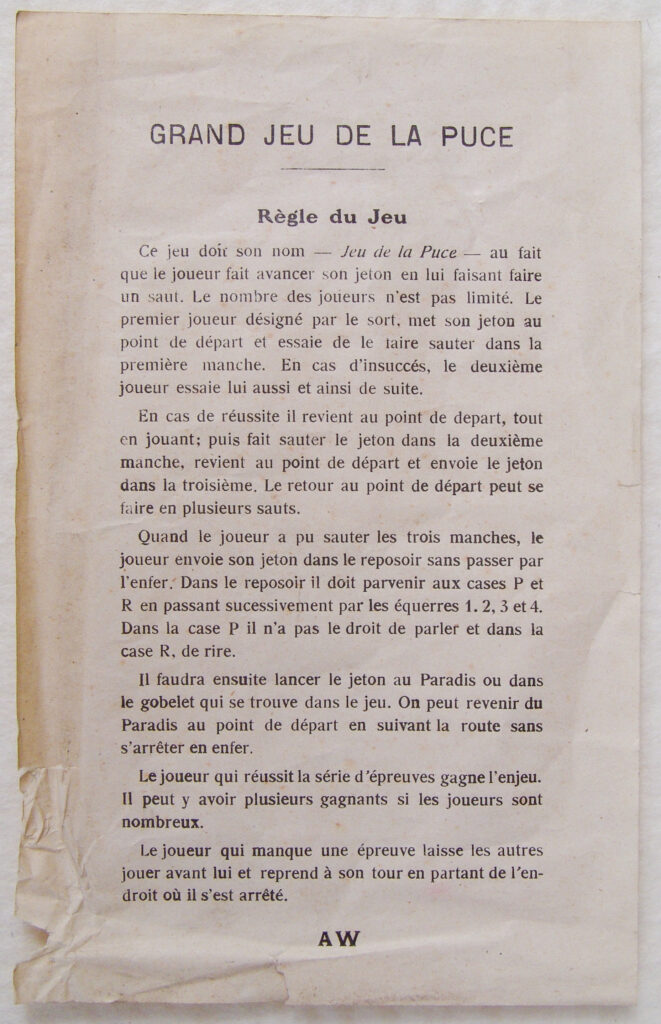
Watilliaux • Paris, France
CABRIOLE • NOUVEAU JEU DE SOCIETÉ (Capers (or Shenanigans) • New Social Game) was published by Charles Watilliaux of Paris, France.
Charles Watilliaux (1847-1924) was a Parisian publisher and manufacturer of toys and games, active in the last quarter of the 19th century and into the 20th. He purchased the business of one Coqueret in or around 1875, renamed it, and remained in operation until selling out to Revenaz and Tabernat in 1907-8. Watilliaux published a wide variety of games and was almost incredibly prolific; he published a catalogue in 1903 that ran to 71 pages and includes more than 2000 card games, games of skill, games of chance and board games, including the Jeu des Explorateurs priced at 8 francs 50 centimes. If the Jeu des Explorateurs is any indication, Wa[ti]lliaux’s games featured extremely high production values, and today they are “highly sought after by collectors”.
Boston Maps website entry for Charlies Watilliaux • retrieved 1 January 2023
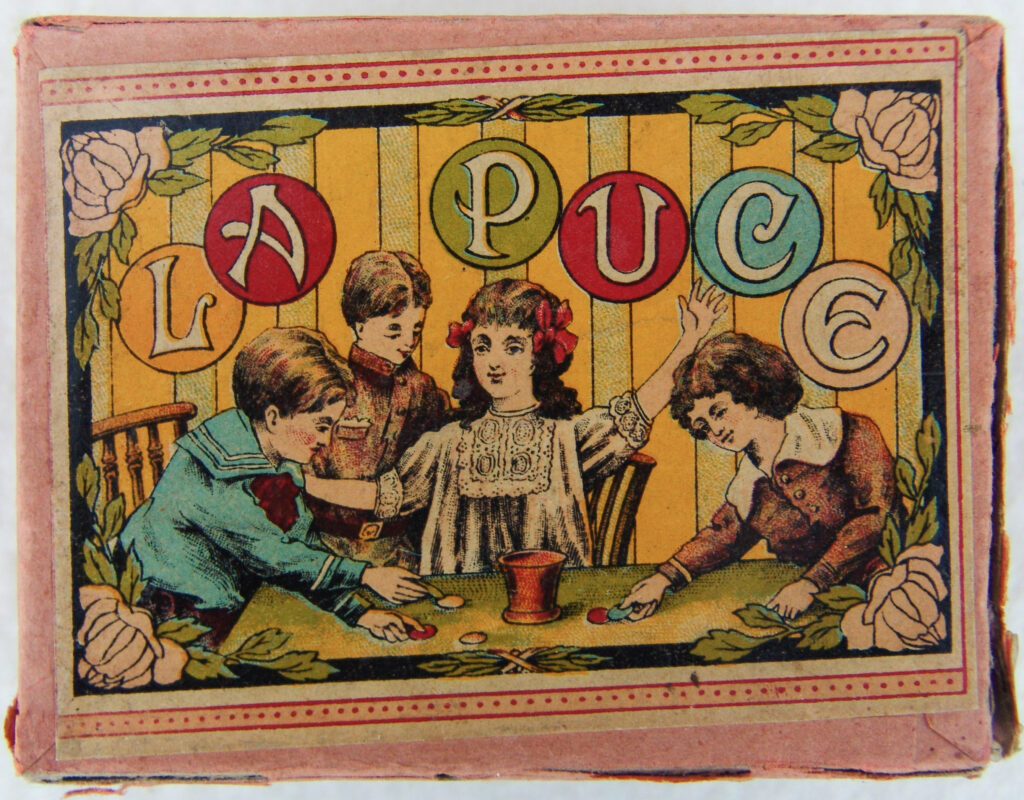
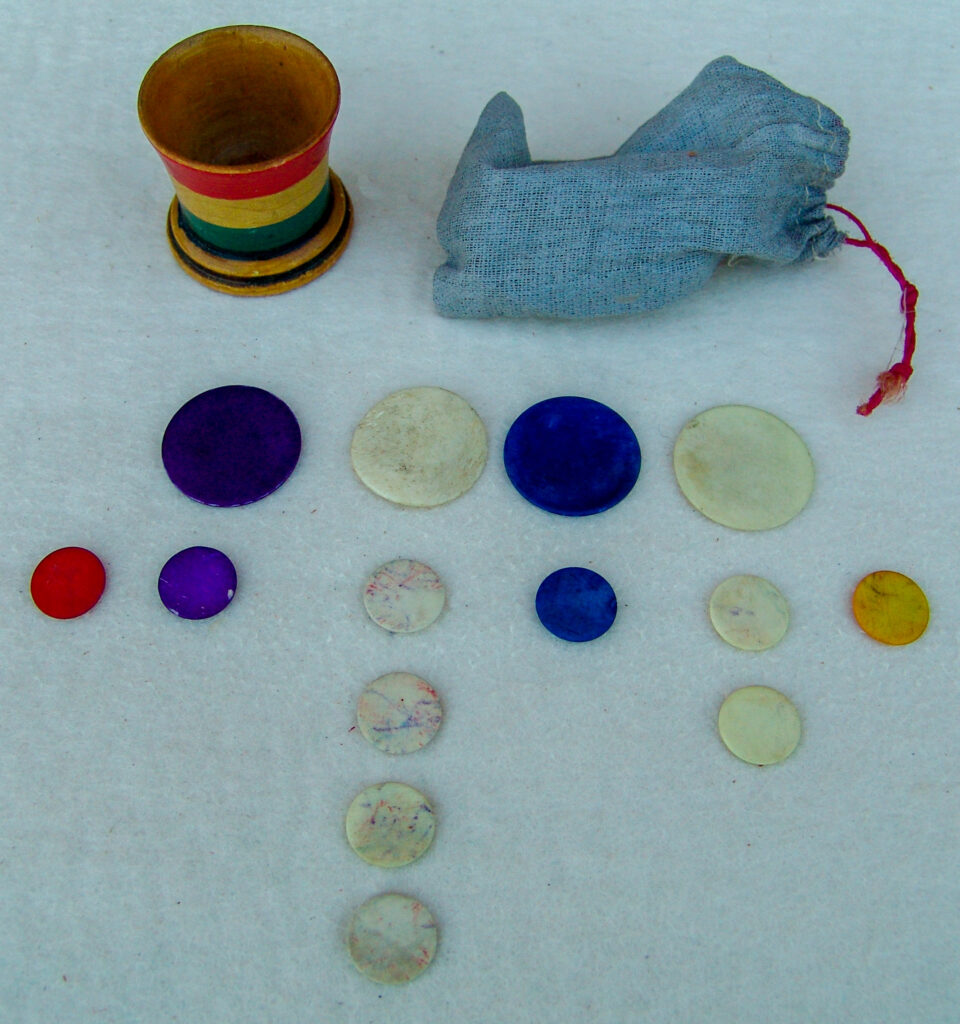
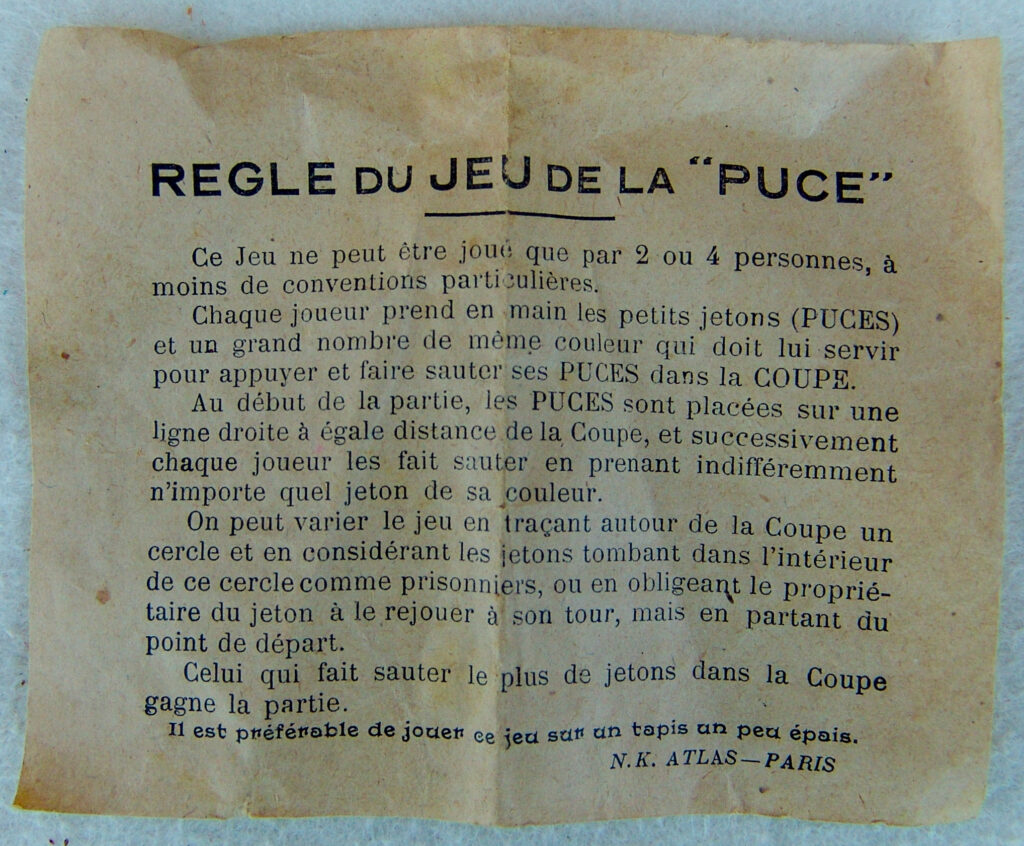
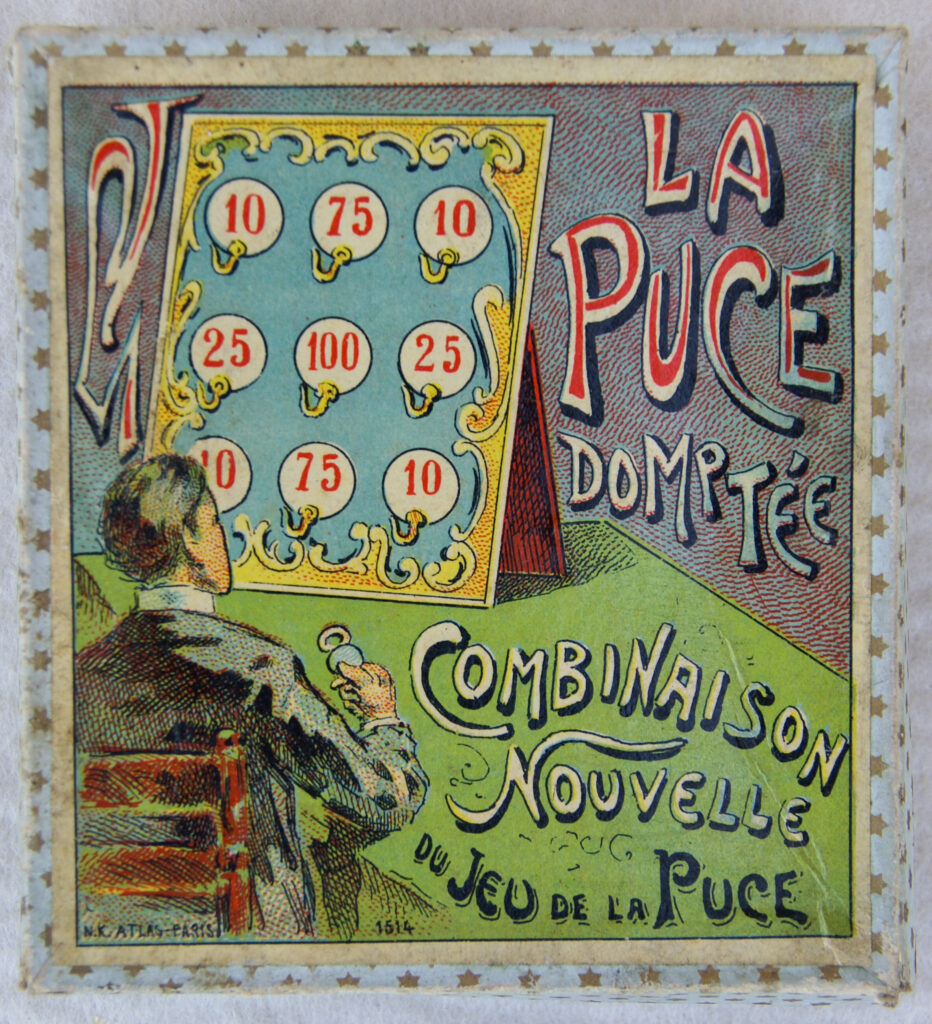
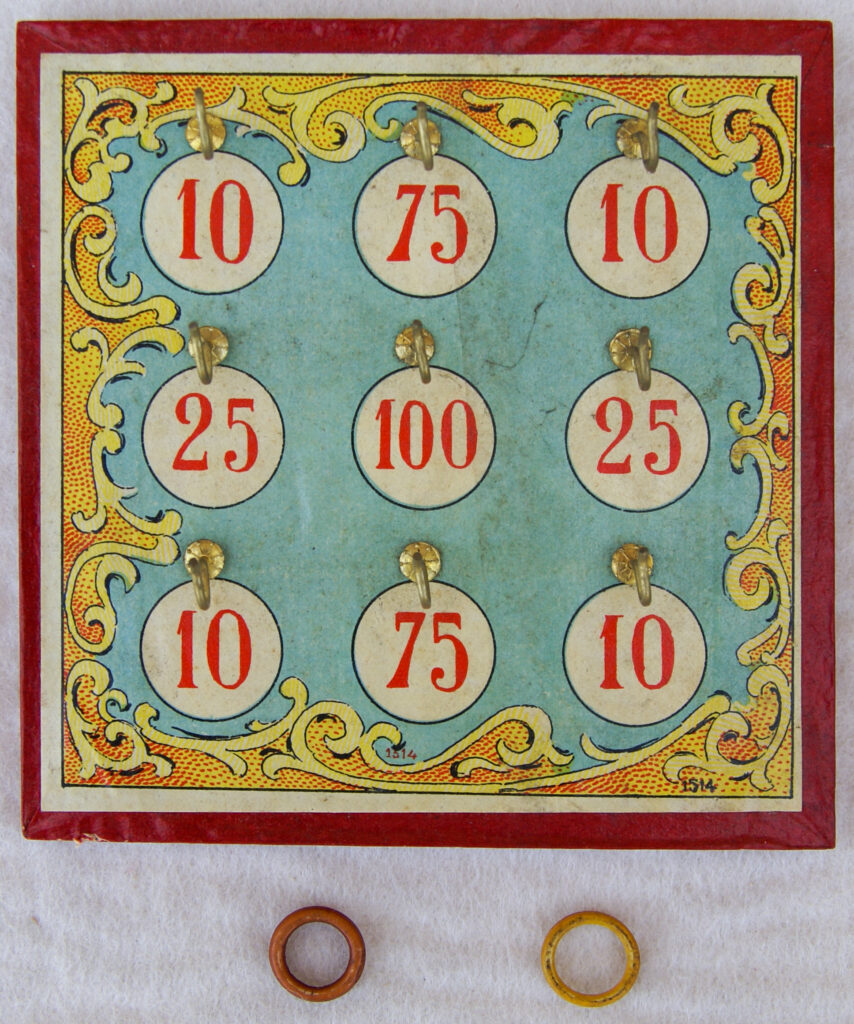
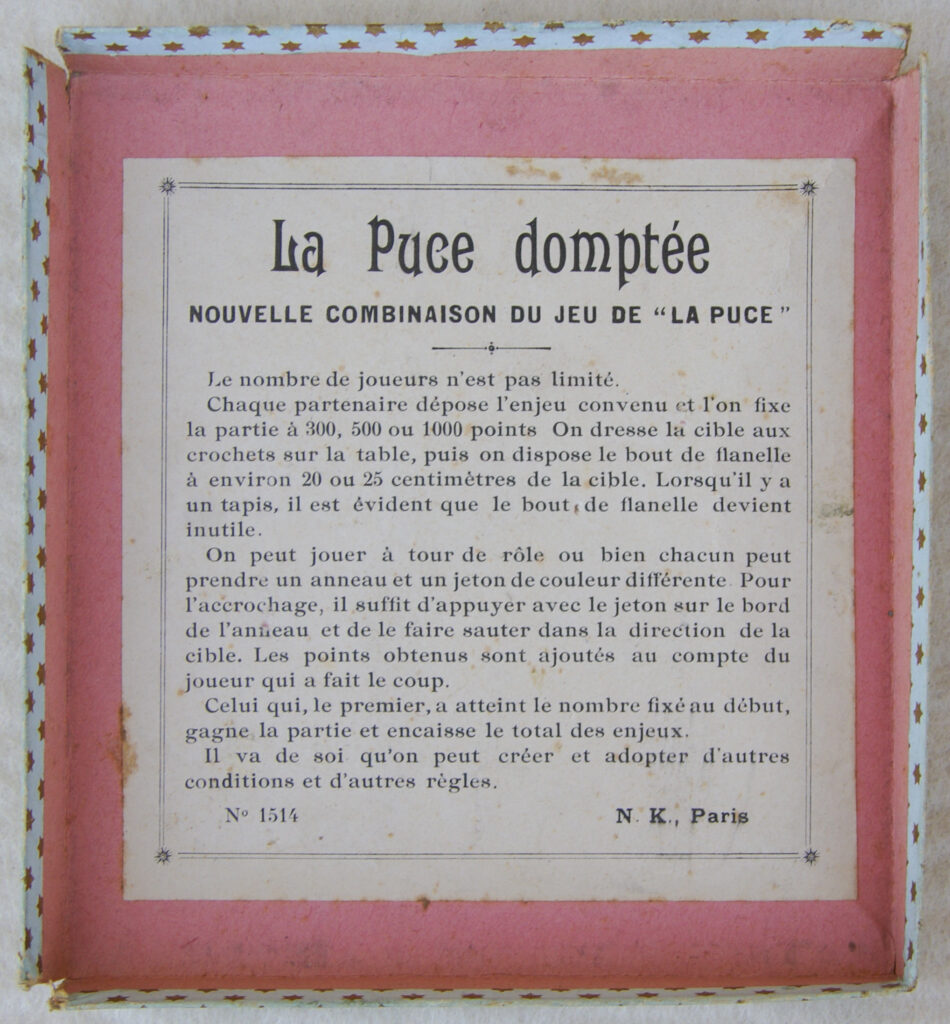
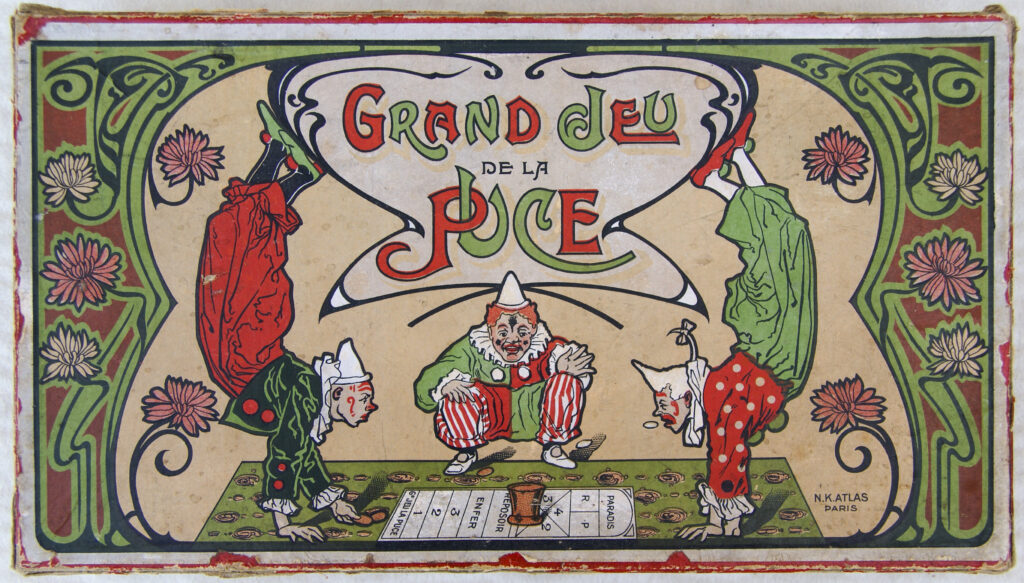
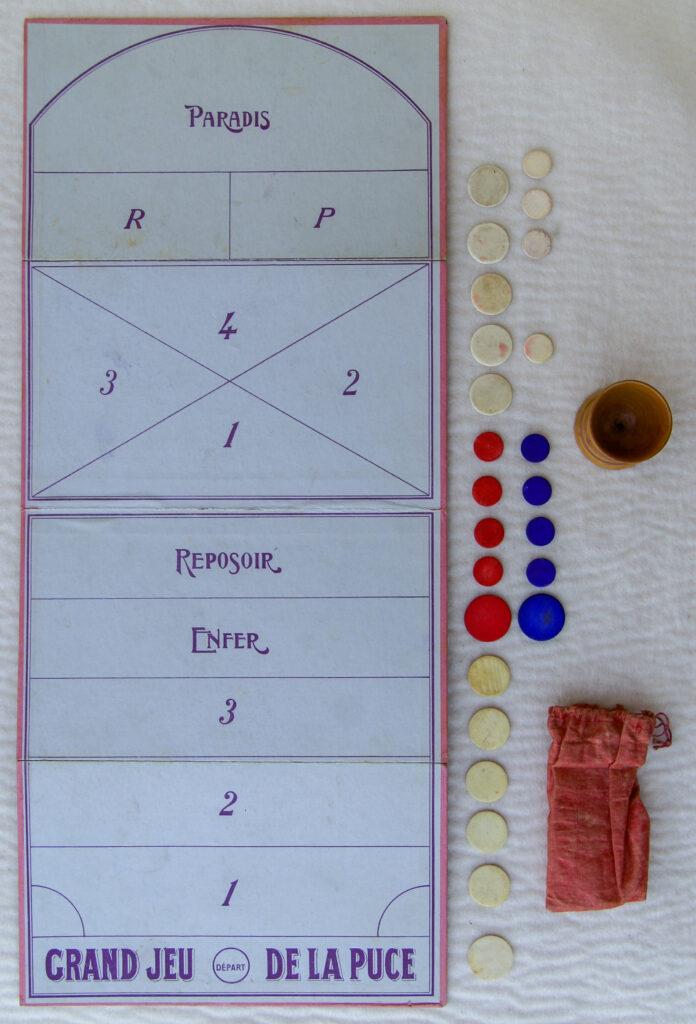
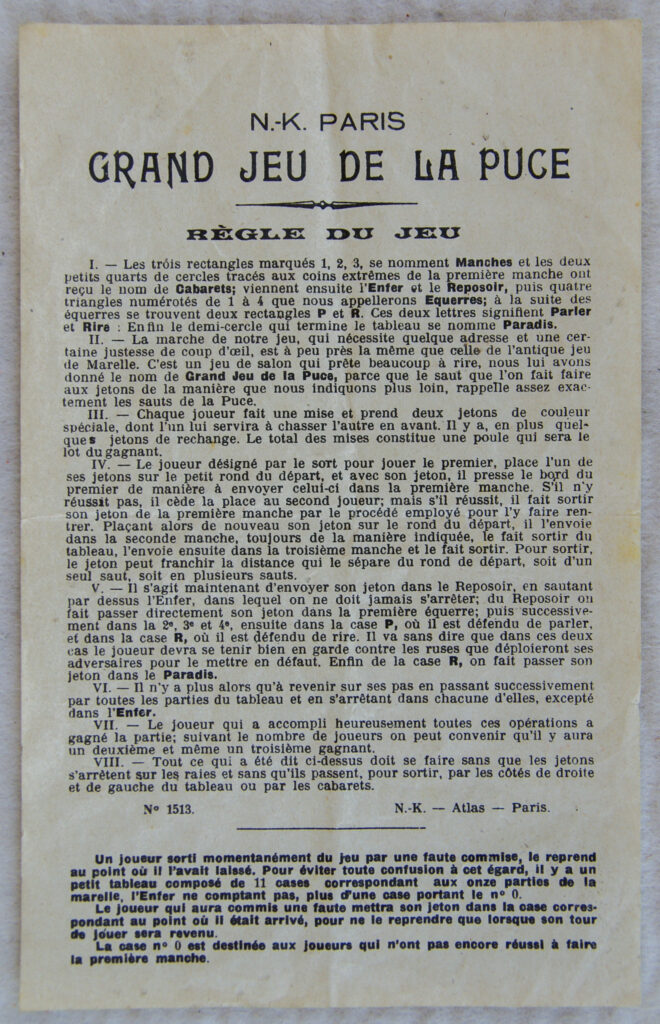
![Tucker Tw ID • MDP-02c1 — publisher • M. D. [Mauclair-Dacier] (Paris) — title • LA PUCE NOUVEAU JEU](https://tiddlywinks.org/wp-content/uploads/2022/12/MDP-02c1-_-G-29897c1-_-Mauclair-Dacier-M-D-Paris-_-LA-PUCE-NOUVEAU-JEU-cover-DSC00316-1024x739.jpg)

![Tucker Tw ID • MDP-02c1 — publisher • M. D. [Mauclair-Dacier] (Paris) — title • LA PUCE NOUVEAU JEU](https://tiddlywinks.org/wp-content/uploads/2022/12/MDP-02c1-_-G-29897c1-_-Mauclair-Dacier-M-D-Paris-_-LA-PUCE-NOUVEAU-JEU-item-winks-pot-squidger-DSC00326-1024x871.jpg)


![Tucker Tw ID • MDP-02c1 — publisher • M. D. [Mauclair-Dacier] (Paris) — title • LA PUCE NOUVEAU JEU](https://tiddlywinks.org/wp-content/uploads/2022/12/MDP-02c1-_-G-29897c1-_-Mauclair-Dacier-M-D-Paris-_-LA-PUCE-NOUVEAU-JEU-rules-page-3-DSC00322-681x1024.jpg)

